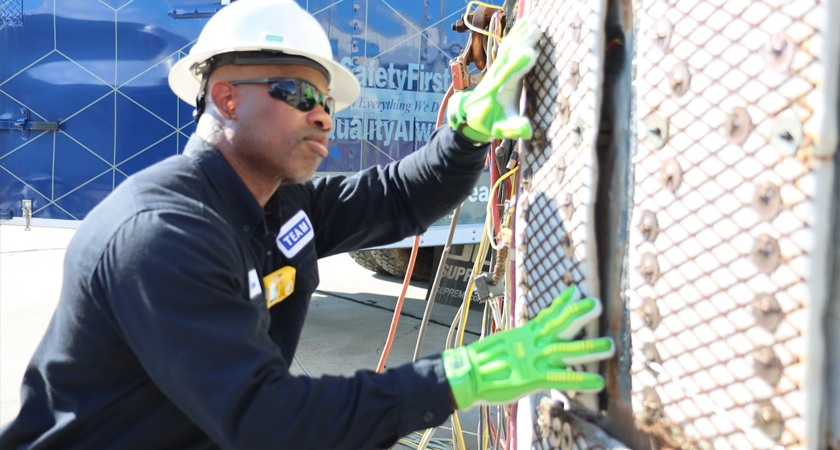Ready to Get Started?
Send us information on you, your company and your project. One of our experts will respond as soon as possible.

Welded metal forms the foundation of the world’s most impressive engineering feats, from our highest skyscrapers to our most advanced aircraft. While welding is essential for bringing structures and machinery to life, it also introduces internal stresses, distortions, and microstructural changes that can weaken a component over time. Post-weld heat treatment (PWHT) serves as the antidote—strengthening welds, refining structures, and ensuring long-term performance.
However, preserving the longevity and reliability of welded components requires more than a one-size-fits-all approach to post-weld heat treatment. Different metals react uniquely to the extreme temperatures and rapid cooling inherent in welding, leading to varying levels of stress, hardness, and structural changes. While necessary in almost every instance, PWHT must be carefully customized to each material to balance strength, ductility, and resistance to environmental factors.
Post-weld heat treatment isn’t just a precaution—it’s a precision-driven process that transforms welded components for long-term reliability. Welding exposes metals to extreme heat and rapid cooling, creating internal stress and structural inconsistencies. PWHT corrects these by gradually heating the weld and heat-affected zone (HAZ) to a controlled temperature, allowing the metal’s microstructure to realign and stabilize.
The weld is then held at this temperature to facilitate stress relaxation, phase transformations, or precipitation hardening, depending on the material. A controlled cooling phase follows, ensuring optimal hardness, toughness, and resistance to thermal fatigue. Without PWHT, welded components risk premature failure, reduced load-bearing capacity, and increased susceptibility to corrosion—issues that can compromise safety and performance in demanding applications.
TEAM specializes in providing customized PWHT solutions, leveraging state-of-the-art technology and decades of expertise to optimize material properties and reinforce structural integrity. From on-site post heat treatment in welding to furnace-based stress relieving, TEAM ensures that welded components meet the highest industry standards.
Learn more by reading our blog: Understanding Post-Weld Heat Treatment (PWHT) and Longevity
In corrosion-prone metals like stainless steel, solution annealing dissolves carbide precipitates, restoring resistance to environmental damage. For high-strength alloys, PWHT ensures structural integrity by mitigating brittleness and improving load-bearing capacity. With tailored processes for each application, post-weld heat treatment extends component lifespan, fortifies against wear, and prepares welded metals for even the most extreme conditions.
Carbon steel is integral to infrastructure, featuring prominently in bridges, pipelines, and industrial machinery. However, welding introduces significant residual stresses and microstructural changes, potentially leading to cracks and failures if not properly managed. Implementing post-heat treatment in welding is essential to mitigate these issues and ensure the longevity of carbon steel structures.
Learn more about Team Inc.’s tempering solutions.
Stainless steel is widely used in industries like pharmaceuticals, food processing, and chemical manufacturing due to its superior corrosion resistance. Welding stainless steel can lead to carbide precipitation, weakening its corrosion resistance. Solution annealing stainless steel is a critical PWHT technique used to restore these properties.
Learn more about annealing for stainless steel.
Learn more about Team Inc.’s material stabilization solutions.
Nickel alloys are essential in aerospace, marine, and power plant applications due to their high-temperature resistance and corrosion protection. However, welding nickel alloys can trigger structural inconsistencies, making post-weld heat treatment critical.
Learn how TEAM’s PWHT solutions can extend the lifespan of nickel alloys.
Titanium is widely used in aerospace and medical industries due to its exceptional strength-to-weight ratio and corrosion resistance. In titanium, welding can introduce microstructural changes that affect performance and durability.
Discover how TEAM’s PWHT solutions can prevent the weakening of titanium alloys.
Aluminum is highly susceptible to softening in the heat-affected zone (HAZ) after welding, reducing its mechanical strength. PWHT is applied selectively to restore lost properties.
Learn how TEAM’s PWHT solutions can fortify aluminum longterm.
Welding is just the beginning—without post-weld heat treatment (PWHT), even the strongest materials can fall victim to stress-induced failures, brittleness, or corrosion over time. Whether it’s stress-relieving carbon steel, solution annealing stainless steel, or stabilizing high-performance nickel and titanium alloys, PWHT plays a crucial role in reinforcing welds, restoring material properties, and ensuring long-term durability.
At TEAM, we don’t just apply post-heat treatment in welding—we customize every process to meet the unique demands of your industry and materials. Our onsite and offsite PWHT solutions are designed to enhance mechanical strength, prevent cracking, and ensure compliance with rigorous industry standards. With state-of-the-art PWHT furnace setups and a team of technical experts, we help clients across aerospace, infrastructure, manufacturing, and power generation achieve superior weld quality that lasts.
When precision matters, TEAM is the trusted leader in post-weld heat treatment solutions—from tempering carbon steel to stabilizing aerospace-grade alloys, we ensure your welded components perform stronger, longer, and safer in even the most extreme conditions.
Ready to Safeguard Your Material’s Potential?
Explore Post-Weld Heat Treatment
With TEAM's online Products and Services Portal, you can shop online for valves, pipeline products and make online requests for mechanical and composite repairs.
Access TEAM PSPSend us information on you, your company and your project. One of our experts will respond as soon as possible.